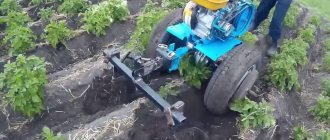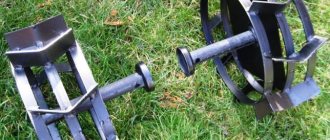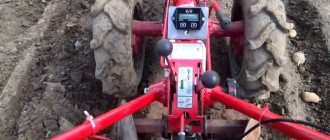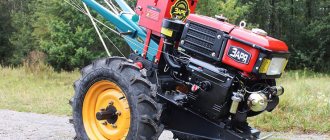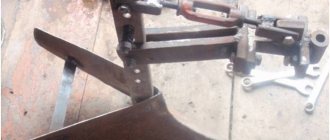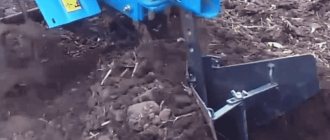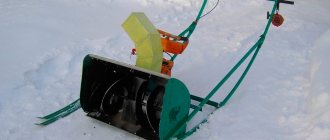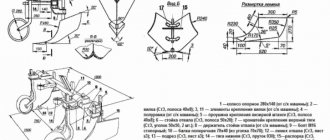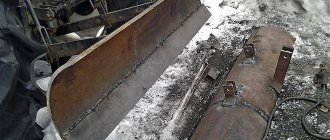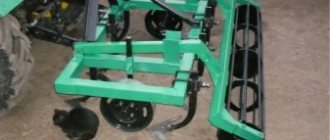Planting and growing potatoes in our country has long become a very popular activity. Therefore, every owner of his own garden often thinks about how to make his work easier and plow, dig and prepare the soil for planting potatoes as quickly and efficiently as possible. Purchasing a walk-behind tractor is a complete solution to these problems. This very valuable unit allows you to effectively plow and cultivate land plots of varying length and degree of soil complexity.
It is not surprising that every happy owner of such a device expresses a desire to use additional attachments in the future in order to significantly expand the capabilities of his assistant. Of course, you can purchase such equipment at specialized retail outlets, but you will have to spend a certain amount of money. Therefore, many people try to make a hiller themselves. In this case, it is not at all necessary to make an exact copy of the factory equipment. The main thing is to take into account the operating principle and general features of the product during manufacturing.
Disc hiller
It is distinguished by excellent efficiency; the operating efficiency and power of the hiller are influenced by the operating speed of the cultivating unit, where at lower rates the power increases. With a disk hiller, the life of the device increases. Having a simple design and a clear operating principle, the hiller does not require much effort during operation. It also does not require special maintenance. Ideal for use before planting potatoes. Disc models are considered the most popular, if only because they are available in several types. The following disc hillers are available:
- With a constant working width - the average constant width is 20-30 cm, set by the manufacturer. Recommended for use with walk-behind tractors of low power and weight.
- With variable working width - they are actively used for hilling various agricultural crops; adjusting the working width will allow you to adjust the hilling for potatoes, and after changing, you can hill up beans with a smaller width. The maximum possible working width is 70 cm, so it is perfectly adjustable for different processes.
Also, many people ask the question: how to set up a disk hiller?
Features of operation and maintenance
Installing a hiller on a walk-behind tractor requires compliance with the rules for adjusting the angle of attack and depth of immersion, and it should be smaller compared to a plow. Wheels and a hitch are installed on the hiller, after which it is connected to the main unit. The walk-behind tractor is placed on a flat surface, while the hiller is lowered and connected by means of a hitch.
When installing attachments, the operator tries to ensure that the hiller stand is positioned vertically. This is the position that is necessary to correctly set the optimal angle of attack. After this, the hitch is lowered to the ground or even slightly deeper into it. It is important that the equipment is positioned below the lug support .
How to set up a hiller?
Using washers and bolts on the hitch bracket. The hiller is attached to the walk-behind tractor. If you are working with an adjustable hiller, it is important to consider parameters such as the depth of immersion into the ground and the width of the immersion angle. The disc hiller must be positioned so that its legs are positioned vertically.
Next, you will have to adjust the width of the angle and the depth of immersion; for this, lanyards and special screws are used, which regulate all indicators. You will have to configure it for specific crops for which hilling is carried out.
Nuances of single- and double-row devices
Depending on the variety, models can be single- or double-row. The good thing about attachments of the second type is that in one pass the operator processes two row spacings at once, raking the soil towards the crop and forming furrows.
Essentially, a double row hiller is like a bracket post that attaches to the hitch and has 2 posts with hillers connected to the hitch via bolts.
The convenience of such models is the ability to adjust the width of the hilling, which allows you to adjust it to the desired parameters of the beds.
The single-row option can process only 1 row per pass. In principle, this is convenient, given that the operator has to spend less time monitoring the progress of the work being performed. This way, the position and movement of the unit will be more correct , which will reduce the percentage of damage to the crop during the hilling process.
Single-row models are especially convenient where the rows are crooked, and they are also easier to operate, although due to their design features they differ in size and have a lot of configurations.
The auger hiller is considered low-productive and is characterized by a high energy intensity of the technological process of hilling agricultural crops.
As for the Dutch models, their wings are capable of rotating in vertical and horizontal planes. This leads to high-quality cultivation of the land with a reduction in energy costs. These models are affordable for most buyers and work quite well.
Propeller type hiller
If your walk-behind tractor has two forward gears, this type of hiller will be an ideal option. The basis of the presented hiller can be called special propellers, the task of which is to first crush the soil and then get out all the unnecessary weeds. The resulting loose soil is available for use, that is, ready for hilling.
Try to use streamlined hillers; they allow you to leave moisture in the soil, because they have less intensity when working with the soil.
What it is?
A hiller for a walk-behind tractor is a device with which you can effectively plow and cultivate land of varying lengths and degrees of soil complexity. Using this attachment, you can hill up cultivated crops, as well as loosen, dig up the soil and fight weeds. Essentially, this is a nozzle made of metal, which is characterized by a wedge-shaped shape. Depending on the type, it has blades or is equipped with rotating disks that are attached to the frame.
Lister hiller
Models with a lister design can be considered the simplest, because they do not have the ability to adjust the working width; the system has already set the furrow width. The average reach of a lister hiller is 30 cm, which is quite average for planting most crops.
The lister hiller works perfectly with most walk-behind tractors; with the racks installed, there is no possibility of overloading the walk-behind tractor.
A Neva walk-behind tractor with a 6.5 hp Subaru engine is suitable for hilling.
Why do you need a hiller for a walk-behind tractor?
This element is used for planting and caring for vegetables.
It works quite simply: after installing the add-on and starting the walk-behind tractor, the part tows the machine across the treated area with planted seeds, thereby sprinkling the future vegetation with the necessary layer of moist and slightly loose soil. Such an operation is of considerable importance, because it allows you to protect the seeds from negative atmospheric influences, increase the level of oxygen saturation, and stimulate growth. Experts note that hilling with a walk-behind tractor also helps rid the soil of excess moisture to avoid rotting. After treatment, the sun’s rays penetrate the soil much better, and some harmful insects end up on the surface, where birds “remove” them. Some weeds are also destroyed, so basic treatment can be safely considered a partial replacement for the use of herbicides. It is important to note that hillers are most often used for processing potato plantings.
Hiller with variable working width
The ability to change the working width is one of the most important characteristics of a hiller, so the presented model can be called the best hiller for a walk-behind tractor. This is the most convenient and effective way to prepare the ground before planting. The design of the hiller involves an adjustment mechanism that can adjust the location of the wings. By setting this indicator correctly, you get the optimal width between the rows. Manufacturers of such models recommend using hillers with variable working widths in conjunction with walk-behind tractors with a power higher than 4 hp. This is an important parameter, otherwise it will harm the walk-behind tractor itself.
Reviews
According to customer reviews, the best hiller for a walk-behind tractor is a disk-type attachment. It is convenient in that it allows you to create ridges on the cultivated land not only of the required width, but also of a given height.
You will learn how to make a hiller for a walk-behind tractor with your own hands in the video below.
Hiller is one of the most effective helpers for planting potatoes. This attachment is used on walk-behind tractors of various types and allows you to bring the process of planting potatoes to automation. Potato hillers for the walk-behind tractor must be purchased separately, but some craftsmen prefer to make the equipment with their own hands. Below we will look at how to make homemade hillers and what you will need.
Plow overview
The plow is used to plow the land in almost any large farm, since without it it is almost impossible to plow the land efficiently, especially if it is dense soil or virgin soil.
During the first treatment, the upper layer is cut and divided into furrows. After the second pass, the lower layer of soil is lifted and mixed with the upper layer. This technique is very effective when fertilizers are scattered on the field and need to be mixed with the soil. The method is also suitable for deepening crop residues into the ground.
The following types of plows are distinguished:
- Leshnoy;
- Negotiable;
- Disk;
- Peeling.
Reversible plow
Plow 2-hull
Single-body plow with skimmer
Rotary plow
There are also several ways to attach plows:
- Trailed;
- Mounted;
- Semi-mounted.
Branded model for MTZ walk-behind tractor
The manufacturer presents a universal model of the reversible plow PU-00.000-01, which is adapted for the Belarus MTZ 09N walk-behind tractor, but is suitable for any MTZ. It copes with plowing land of any density, including virgin soil. Features include the low weight of the plow, which is only 16 kg.
Plow PU-00.000-01
During plowing, the working area is 30 cm, which allows you to significantly save time. The maximum depth can reach up to 25 cm, but it can be adjusted using the stand and the holes on it. The design of the plow involves not only plowing, but also provides the opportunity to dig up root crops. And thanks to the simple fastening using a hitch, preparing the walk-behind tractor will not take much time.
The appearance of the plow is designed in such a way that the lower part cuts the layer of earth and grabs it, and the upper part throws the layer to the side. This design allows you to throw the earth to the side so that it does not crumble back into the laid trench. Thanks to the use of durable steel, the device does not deform over time and does not corrode, and can be used for a long time under any load.
Universal plow for the Belarus walk-behind tractor (PU-00.000-01)
Analogs for MTZ walk-behind tractor
As an alternative, which can be used together with the Belarus MTZ walk-behind tractor, the following plow models can be considered:
The P1-20/3 plow is produced by the Russian company, which is located in the city of Gagarin. The shape is similar to the branded model, but with some differences. Reduced weight to 8 kg. and the single grip of the ploughshare is 21.5 cm, which is almost a third less than that of PU-0000001. Because of this, it is more advisable to use the model in small areas with medium-density soil.
Plow P1-20/3
The double-body plow, due to its design, has special operating features. The pointed end of the plow easily enters the soil and is not immediately thrown to the side, as it does when using a universal model, but turns over. Due to this, it is possible to achieve improved soil mixing. The width of the plowshare of the tool is 15.5 cm, and plowing is carried out to a depth of 20 cm.
Crop care
A walk-behind tractor and various attachments will make further care of the potato plantation easier.
Treatment after germination
The time from planting to the first potato shoots is the most important for the formation of full-fledged and healthy tubers. Germination will begin from the upper buds. The main thing that should not be allowed is breaking off sprouted branches. This will negatively affect the growth and development of potato fruits.
The role of the plow
After the first shoots appear, a weeder is used to weed and loosen the soil between the rows. It performs the tasks of a conventional plow.
Hilling
Accelerates the development of stems, destroys weeds and protects the plant from possible frosts. Performed 2–3 weeks after germination. A hiller is used for work.
Spraying with a walk-behind tractor
This can be done using a special sprayer, which is equipped with a pump.
Wire harrow for weeding
To remove weeds after sowing, but before the first shoots appear, a mesh weeding harrow is used, which is fixed to the frame of the walk-behind tractor and pulled across the field.
Tuber preparation
The potatoes should be the same size. If the tubers are too large, they need to be cut, which will increase the risk of disease development and open access to pests.
Germination will take about a month. The planting material should be placed in a warm and bright room (+12-15 degrees). If dark spots begin to form on fresh sprouts, this indicates a disease. Tubers that are infected should be discarded.
Before planting, potatoes need to be soaked in stimulating and pickling solutions.
Important! It is not recommended to keep seed in solutions for a long time. It is better to lay the tubers on a flat surface, spray them with preparations and leave them to dry.
After the earth warms up to about +8 degrees, you can begin planting root crops.
Soil preparation
Pre-sowing work should begin with the laying of organic and mineral fertilizers in the autumn.
Stages of sowing in spring
Right before planting, you need to plow the soil to about 15 centimeters. For this procedure you will need a special attachment - a cutter.
Before planting the crop under the Neva walk-behind tractor, it is necessary to remove the wings of the unit. The main thing is to correctly configure all the equipment that is installed on the walk-behind tractor. This is necessary so that the car runs smoothly and requires little effort.
Advice! If you plow the soil well, you will not need to harrow the soil.
Hurming is necessary to ensure that the soil is saturated with moisture and oxygen. In well-loosened soil, the crops will sprout together.
It is at this stage that the walk-behind tractor will help facilitate the process of preparing the soil before sowing.
